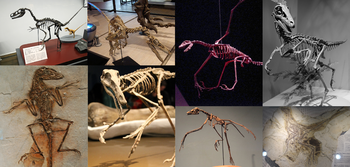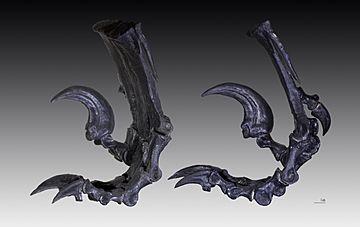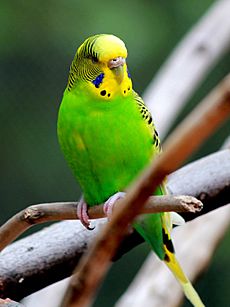Paraves facts for kids
Quick facts for kids Paravians |
|
|---|---|
 |
|
| Examples of basal paravian dinosaurs | |
| Scientific classification |
|
| Kingdom: | Animalia |
| Phylum: | Chordata |
| Clade: | Dinosauria |
| Clade: | Saurischia |
| Clade: | Theropoda |
| Clade: | Pennaraptora |
| Clade: | Paraves Sereno, 1997 |
| Subgroups | |
|
|
| Synonyms | |
|
|
Paraves are a large group of theropod dinosaurs. They first appeared during the Middle Jurassic period. This group includes well-known extinct dinosaurs like dromaeosaurids (think of Velociraptor) and troodontids.
But here's a cool fact: Paraves also include avialans. This means they include all the different kinds of birds alive today, which are over 10,000 species! So, birds are actually living dinosaurs. Early Paraves are famous for having a special, large claw on their second toe. They often held this claw off the ground when they walked. Scientists are still learning about how different Paraves are related to each other. New fossil finds and studies keep changing what we know.
Contents
What Are Paraves Like?
Like other theropods, all Paraves walked on two legs. This is called being bipedal.
Their Teeth and Diet
The teeth of early Paraves were curved and had small saw-like edges. This helped them eat meat. Some species, like Dromaeosaurus albertensis, had very sharp, blade-like teeth. The teeth of dromaeosaurids and troodontids had tiny serrations on the front edge. The back edge had larger, hooked serrations.
Most early Paraves were meat-eaters. However, some smaller species, especially troodontids and early avialans, ate both plants and meat. Scientists think that eating both might have been common for the first Paraves. Eating only meat probably developed later in some groups. Fossils also show that many early Paraves had feathers covering their legs and feet. This trait might have started in an even older group of dinosaurs called Coelurosaurs.
Wings and Feathers
Paraves usually had long front limbs that looked like wings. These wings became smaller in species that couldn't fly. Early Paraves had three large, flexible fingers with claws on their wings. In more advanced species, these fingers grew together and became stiff. Their claws also became much smaller or disappeared.
The wrist joint in Paraves became more flexible over time. This allowed their front limbs to grow longer and their feathers to develop more. These changes were important steps that made flapping flight possible.
Many early Paraves had well-developed wings and long feathers on their back legs. These leg feathers sometimes formed a second set of "wings." Dinosaurs like Microraptor gui are famous examples of these "four-winged dinosaurs." Some scientists first thought these leg wings might have made it hard for them to walk on the ground. They thought these dinosaurs must have lived in trees. However, later studies showed that early Paraves like Microraptor could flap their wings and launch themselves into the air from the ground. This means they didn't need to climb trees to fly. Microraptor shows that flight could have evolved more than once within the Paraves group.
Feet and the Sickle Claw
Most theropods walked with three toes touching the ground. But many early Paraves, including dromaeosaurids, troodontids, and some early avialans, held their second toe up. Only their third and fourth toes touched the ground. This is called functional didactyly. The second toe had a very large, curved, sickle-shaped claw. This claw was usually held off the ground when they walked. In large predatory dromaeosaurs, this claw was especially big and flattened.
The first toe, called the hallux, was usually small and pointed inward. In more advanced birds, this toe became fully reversed. One unique species, Balaur bondoc, had both its first and second toes modified. Both toes on each foot were held up and had large, sickle-shaped claws.

The "sickle claw" on the second toe is one of the most famous features of Paraves. It was especially developed in dromaeosaurids and troodontids. For a long time, scientists wondered what this claw was for. Some thought it was used to cut open large prey. However, studies of the claw's shape showed it wasn't good for cutting. It seemed more like a hooking tool.
In 2006, scientists suggested the claws were like crampons. They thought the claws helped Paraves climb, perhaps even climbing onto the sides of very large prey. A bigger study in 2011 agreed that the sickle claws were not for cutting. They compared the feet and claws of early Paraves to modern birds of prey. Many modern birds of prey also have enlarged claws on their second toes. These claws help them grip and hold prey. They use their body weight to pin the prey to the ground and eat it alive.
This idea fits well with the anatomy of advanced dromaeosaurids like Deinonychus. They had strong tendons in their toes and feet. This suggests they used their claws to puncture and grip prey, pinning it down. They might have used shallow wing beats and tail movements to stay balanced. Other clues support this idea: their teeth had large, hooked serrations only on the back edge, which is good for pulling flesh upwards. Also, they had large claws on their wings, which could help them move prey around while covering it with their wings.
In more primitive dromaeosaurids and troodontids, the feet were not as specialized. Their claws were not as large or hooked. Their toe joints allowed more movement. This suggests these species hunted smaller prey that could be pinned using only their inner toes. Their feet didn't need to be as strong or sturdy.
Changes in Body Size
Paraves show extreme changes in body size. Their ancestors started to shrink about 200 million years ago. Fossils show that this group of theropods evolved new features four times faster than other dinosaur groups. They also shrank 160 times faster than other dinosaur groups were growing.
Scientists believe the common ancestor of Paraves was quite small. It was about 65 centimeters (25 inches) long and weighed about 600–700 grams (1.3–1.5 pounds). Later, some groups within Paraves, like dromaeosaurids and troodontids, grew much larger. This happened four separate times: three times in dromaeosaurids and once in troodontids. Meanwhile, many bird species continued to get smaller. All the earliest Paraves found so far were small. Troodontidae and Dromaeosauridae gradually increased in size during the Cretaceous period.
How Paraves Evolved
The name Paraves means "beside birds" in Greek. It was first used by scientist Paul Sereno in 1997. Paraves includes all dinosaurs that are more closely related to birds than to oviraptorosaurs. This means the first Paravian was the common ancestor of birds, dromaeosaurids, and troodontids.
Paraves usually includes three main groups:
- Avialae: This group includes Archaeopteryx and all modern birds.
- Dromaeosauridae: This group includes dinosaurs like Velociraptor and Deinonychus.
- Troodontidae: This group includes dinosaurs like Troodon.
Scientists use different ways to group these animals. For example, the name Eumaniraptora was given to a group that includes avialans and deinonychosaurs. Paraves and Eumaniraptora are often considered to be the same group.
Since the 1960s, dromaeosaurids and troodontids were often grouped together in a clade called Deinonychosauria. This was mainly because they both had the special retractable second toe with a sickle-claw. However, more recent studies suggest that troodontids might be more closely related to birds than to dromaeosaurids. This means the way scientists define Deinonychosauria might need to change.
When and Where They Started
Paraves separated from other maniraptoran dinosaurs around 165 million years ago. Then, about 110–90 million years ago, the ancestors of modern birds split off from the other Paraves.
Except for modern birds, there are no living Paraves today. This means scientists learn about their entire family tree only from fossils. The most famous early Paraves fossil is Archaeopteryx. Scientists have found 11 specimens of Archaeopteryx, some complete and some partial.
See also
 In Spanish: Paraves para niños
In Spanish: Paraves para niños
- Origin of birds
- Origin of avian flight
- Evolution of birds
- Biogeography of paravian dinosaurs
- The thecodont hypothesis of bird origins
- Proavis, a hypothetical dinosaur-bird intermediary
- Temporal paradox (paleontology)
- List of fossil bird genera
- Protoavis texensis, a putative but possibly chimeric Triassic bird


